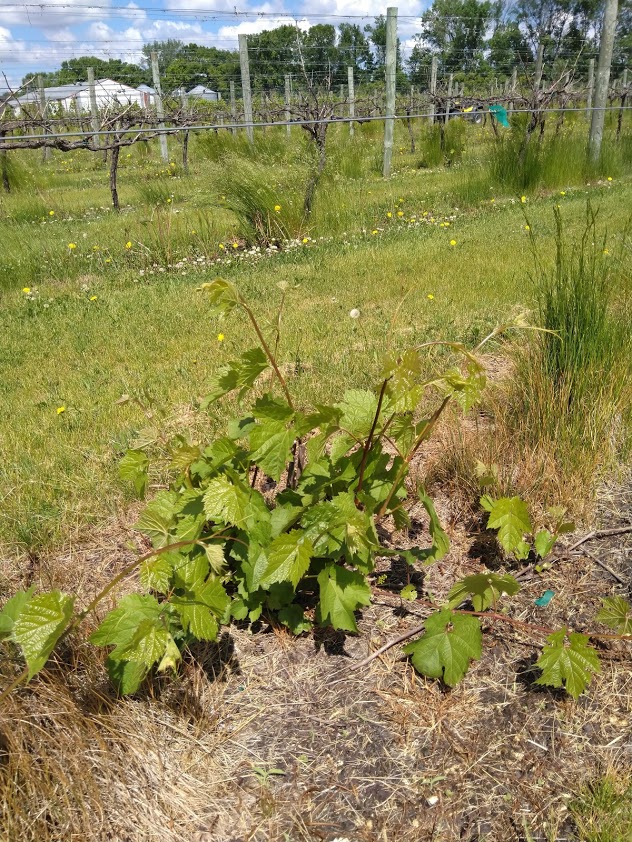Annie Klodd, University of Minnesota Extension, [email protected]
Many vineyards across Minnesota have been severely affected by winter injury, while others survived the winter well. For the vineyards reporting winter damage, many are reporting partial or entire blocks of one variety to have died to the ground, often leaving behind multiple suckers per vine. So far, more damage has been reported on lower sites with higher water tables or more wet, humid environments; while sites on higher ground seem to have faired better overall. Damage also varies by variety. It is also likely that vines that were less healthy going into last winter suffered more extensive damage, although more data must be collected in order to make that conclusion. A formal multi-state survey will be conducted to determine which varieties, site types, and geographic areas were most affected.Rejuvenating Grapevines Following Severe Winter Damage
If a vine is dead to the ground but has several healthy suckers growing from the base of the trunk, leave roughly five suckers on the vine and select one to train up to become a replacement trunk. If the vine has more than about five suckers, trim the rest off; or if you have less than five, leave as many as you can. Choose a healthy, strong sucker to be your new trunk, but avoid selecting a bull cane (a bull cane is more than pinky-finger diameter, with wide bud spacing). The reason to leave extra suckers is to distribute some of the excess energy that is in the vine's root system and reduce the risk of the vine developing bull canes. Once you have chosen your new "trunk" shoot, use tapener tape or other fasteners to secure it vertically upward onto a fresh bamboo pole or rebar.
In order to spray herbicides, treat these as you would new vines; apply grow tubes so that you can safely spray herbicide around the vines without injuring the suckers. Try to maneuver the suckers into the grow tube. If the suckers are running along the ground and are very thick, it may be too late to get them all into the grow tube without breaking some. At that point, you may consider leaving the weeds, weed-whacking around the vines instead of spraying, or removing the shoots that are causing problems. Leaving the weeds may take away excess vigor from the vines, if that is an issue on the particular site. Therefore, these decisions depend on the needs and goals of the particular vineyard to some extent.
Remove the grow tubes no later than October, or whenever you are done with your last herbicide spray of the season. Leaving them on past mid-fall could lead to poor winter acclimation and further winter damage the next year. During winter pruning, prune off the excess suckers and consider training up one of them as a second "insurance" trunk.
When to remove the dead trunk
You can remove the dead trunk now (June) if it is not producing anything, using loppers or a saw. If the trunk is partially alive and producing a few clusters, it is acceptable to leave it there for the season and cut it down during winter pruning. The fruit may not be high quality if the vine is unhealthy, but it will help distribute some of the excess energy in the roots.
Is Grapevine Trunk Disease Contributing to Vineyard Die-back?
There has been much discussion about the role of grapevine trunk disease (GTD) in vine die-back in the Midwest. At this point, it is not known how much GTD is contributing to winter die-back in the Midwest. Laboratory analyses are currently underway at the University of Minnesota to help determine this, but at this point it is not possible to say how much it is contributing, and it likely varies depending on the vineyard and on the overall health of the vines. Dispite contradictory claims online, trunk disease species cannot be reliably diagnosed without the help of trained plant pathologists, of whom we are currently working with on this issue.
As a precaution, when growers cut down trunks to re-train new trunks, they may spray each pruning cut with Rally or Topsin, or apply latex paint. I recommend bringing a small backpack sprayer or handheld sprayer with these products while cutting down trunks in order to make this process more efficient.
Photos: (top) A vine that died to the ground, with the trunk removed. One sucker should be chosen as the new trunk and trained up on a pole. (bottom) Healthy Frontenac blanc on the left and a dead block of Marquette on the right (photo credit Annie Klodd, 6/12/2019).

